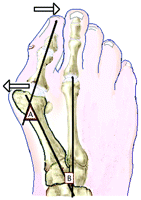Bunions are a burden for many, but they don’t necessarily have to be a permanent part of your life. Officially known as hallux valgus, bunions develop when the big toe begins to point toward the second toe, resulting in a swollen and painful deformity at the big toe’s middle joint (Figure 1.). Bunions rank as the most common forefront deformity, affecting between 25 and 35 percent of the adult population.¹ ² Women are more prone to the condition than men, and both genders are more prone to developing bunions as they get older.¹ ²

Figure 1. Hallux valgus disrupts normal alignment of the metatarsophalangeal joint. Glasoe WM et al. PHYS THER 2010;90110-120
Where Bunions Come From
Tight-fitting shoes and high-heels are often blamed as the sole cause of bunions, although the condition is more likely caused by a number of factors at work.³ Ill-fitting shoes that put undue pressure on your forefoot can indeed contribute to the development of bunions, but so can genetic predisposition for the condition.⁴
Other factors that contribute to bunions include an imbalance in strength of the foot muscles, hindfoot pronation, a contracted Achilles tendon, lax or excessively mobile joints, and an angling of the big toe’s first bone that pushes the big toe’s second bone toward the other toes.³ ⁵⁻¹⁰
Obesity can also play a role in many musculoskeletal foot disorders, as can variations in body mechanics through your pelvis and lower extremities.¹¹ ¹² One more contributing factor is an imbalance in the lineup of ligaments, muscles and other tissues connected to and supporting the big toe.¹³ ¹⁴
Damage if Left Untreated
Bunions typically come with a trio of issues that cause additional problems and potential pain.¹ The swollen protrusion that develops in the big toe is an early symptom, followed by the crowding and misalignment of the other toes. The smaller toes frequently start to angle upwards, resulting in the unsightly condition known as hammer toe.
The third issue at work is the disruption of your big toe’s functioning and your gait. Proper biomechanical movement of your foot involves the windlass mechanism, which relies on the big toe acting as a lever to propel you forward. Bunions ensure your big toe can no longer properly serve as the lever that is part of the windlass mechanism’s process, making your gait unbalanced and less energy efficient.
The pressure and overload on the rest of your foot can result in excruciating pain, stress fractures, loss of mobility and a condition known as sesamoiditis, or pain and inflammation of the bones on the bottom of your foot behind the big toe.¹⁵ Older adults may move more slowly, take shorter steps and become more prone to falling when afflicted with bunions.¹⁶
Let your bunion develop even further, and your disrupted gait pattern may contribute to even bigger problems, such as the painful knee condition of patellofemoral pain syndrome.¹⁷
Correction and Prevention
Plopping a lift in your shoe and calling it a bunion correction doesn’t cut it. Surgery remains the most prevalent correction method for the most severe cases of bunions, although other techniques can be helpful to halt the progression before surgery becomes the only answer. Keeping your feet and gait properly strengthened and stabilized through a regular Foundation Training and/or Pilates practice may help keep the progression or development of bunions at bay.
Exercises that spread out the toes have been shown to be effective for helping early stage bunions, and you may also find relief with specific exercises that counteract the effects of your pointy-toed shoes, high heels or other negative factors that contribute to bunion development.³
REFERENCES:
- Wülker N, Mittag F. The treatment of hallux valgus. Dtsch Arztebl Int. 2012;109(49):857-68.
- Nix S, Smith M, Vicenzino B. Prevalence of hallux valgus in the general population: a systematic review and metaanalysis. J Foot Ankle Res. 2010;3:21-29
- Kima M, Kwonb O, Kimc S, Jung D. Comparison of muscle activities of abductor hallucis and adductor hallucis between the short foot and toe-spread-out exercises in subjects with mild hallux valgus. J Back Musculoskelet Rehabil. 2013;26:163-168.
- Einarsdottir H, Troell S, Wykman A. Hallux valgus in ballet dancers: a myth? Foot Ankle Int.1995;16:92-4.
- Arinci Incel N, Genc H, Erdem HR, Yorqancioqlu ZR. Muscle imbalance in hallux valgus: an electromyographic study. Am J Phys Med Rehabil. 2003;82(5):345-349.
- Coughlin MJ. Hallux valgus. J Bone Joint Surg Am. 1996;78:932-966.
- Hardy RH, Clapham JC. Observations on hallux valgus; based on a controlled series. J Bone Joint Surg Br.1951;33(3):376-391.
- Hoffmeyer P, Cox JN, Blanc Y, Meyer JM, Tailard W. Muscle in hallux valgus. Clin Orthop Relat Res. 1988;232:112-118.
- Inman VT. Hallux valgus: A review of etiologic factors. Orthop Clin North Am. 1974;5(1):59-66.
- Kilmartin TE, Barrington RL,Wallace WA.Metatarsus primus varus. A statistical study. J Bone Joint Surg Br. 1991;73(6):937-940.
- Butterworth PA, Landorf KB, Smith SE, Menz HB. The association between body mass index and musculoskeletal foot disorders: a systematic review. Obes Rev. 2012;13:630-642.
- Incel N, Genc H, Yorganicioglu ZR, Erdem HR. Relation Between Hallux Valgus Deformity and Lumbar and Lower Extremity Biomechanics. Kaohsiung J Med Sci. 2002;18:329-333.
- Perera AM, Mason L, Stephens MM. The Pathogenesis of Hallux Valgus. J Bone Joint Surg Am.2011;93:1650-61.
- Van Beek C, Greisberg J. Mobility of the First Ray: Review Article. Foot Ankle Int. 2011;32: 917-922.
- Kennedy J, Collumbier J. Bunions in Dancers. Clin Sports Med. 2008;27:321-328.
- Nix S, Vicenzino B, Collins N, Smith MD. Gait parameters associated with hallux valgus: a systematic review. J Foot Ankle Res. 2013;6:9-20.
- Kaya D, Atay O, et al. Hallux valgus in patients with patellofemoral pain syndrome. Knee Surg Sports Traumatol Arthrosc. 2009;17:1364-1367.
